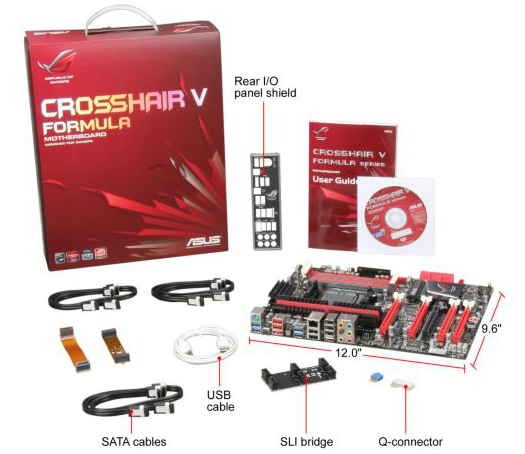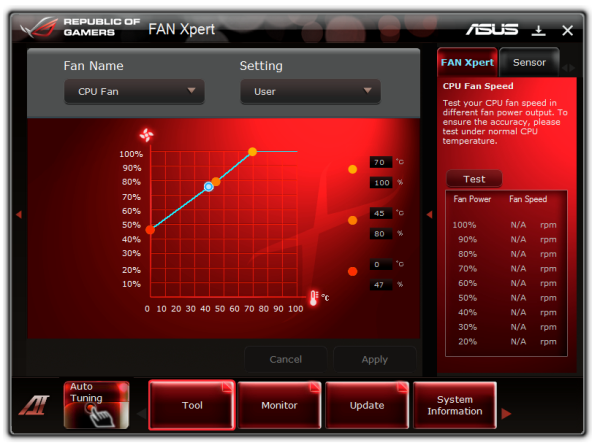990FX Motherboard Roundup with Thuban and Bulldozer – A Second Wind for ASUS, Gigabyte, MSI and Biostar
by Ian Cutress on April 5, 2012 11:00 AM ESTASUS Crosshair V Formula In The Box
For a top of the range Republic of Gamers’ motherboard, we all want goodies in the box. With the Crosshair V Formula, we get plenty of SATA cables and SLI connectors to fit the bill.
IO Shield
Driver CD
User Guide
Six SATA cables (locking, right angled)
Tri-SLI bridge
SLI bridge
Crossfire Cable
Q-Connectors

Image courtesy of Newegg
Board Features
| ASUS Crosshair V Formula (990FX) | |
| Price | Link to Newegg |
| Size | ATX |
| CPU Interface | AM3+ |
| CPU Support | AMD FX/Phenom II/Athlon II/Sempron 100 |
| Chipset | AMD 990FX |
| Base Clock Frequency | 200.7 MHz |
| Core Voltage | Auto, 0.675 V to 2.300 V |
| CPU Clock Multiplier | Auto, 4.0x to 39.5x |
| DRAM Voltage | Auto, 1.20 V to 2.90 V |
| DRAM Command Rate | Auto, 1T or 2T |
| Memory Slots |
Four DDR3 DIMM slots supporting up to 32 GB Up to Dual Channel Support for DDR3, 1066-2133 MHz, ECC or Non-ECC |
| Expansion Slots |
3 x PCIe Gen2 x16 (x16/x16 or x16/x8/x8) 1 x PCIe Gen2 x4 1 x PCIe Gen2 x1 1 x PCI |
| Onboard SATA/RAID |
6 x SATA 6 Gbps, Support for RAID 0, 1, 5, 10 1 x SATA 6 Gbps (ASMedia ASM1061) |
| Onboard |
7 x SATA 6 Gbps (6 Chipset, 1 Controller) 8 x Fan Headers 2 x USB 2.0 Headers 1 x USB 3.0 Headers 1 x S/PDIF Output Header 1 x Front Panel Header 8 x Measure Points 1 x Clear CMOS Header 1 x 4-pin Molex Connector Power/Reset Buttons OC / ROG Level Up Button 1 x Go Button |
| Onboard LAN | Intel 82583V |
| Onboard Audio | SupremeFX X-Fi 2 |
| Power Connectors |
1 x 24-pin ATX connector 1 x 8-pin 12V connector 1 x 4-pin 12V connector 1 x 4-pin Molex connector |
| Fan Headers |
2 x CPU Fan Headers (4-pin) 3 x CHA Fan Headers (4-pin) 3 x OPT Fan Headers (4-pin) |
| IO Panel |
1 x Keyboard/Mouse PS2 Port 1 x Clear CMOS Button 1 x Optical SPDIF Output 8 x USB 2.0 4 x USB 3.0 1 x eSATA 3 Gbps 1 x Gigabit Ethernet Audio Outputs |
| BIOS Version | 1003 |
| Warranty Period | 3 Years |
The ROG board is the only 990FX we are testing today to have an Intel network controller, a non-Realtek audio solution, and one of only two to support ECC memory according to the specifications.
Software
The bulk of ASUS’ software is always to be found in AI Suite, and in the land of ROG motherboards, we get a ROG specific skin. Also to hand is a ROG themed CPU-Z, in order to detect accurately the clock speed of the processor.
AI Suite II: As this software is now a few generations into the ASUS blood line, the effort from ASUS to have seamless integration and complete functionality is paramount. Needless to say, on the whole we are not disappointed. We have full control over the fans in the case through the Fan Xpert utility:
Overclocking through this utility is also part of the package. For users wanting a quick, permanent overclock, the Auto Tuning offers two modes labeled Fast and Extreme (see the overclocking section on the previous page to see the results of this on both Thuban and Bulldozer). For in operating system overclocking, users can proceed to the TurboV Evo section to select voltages, CPU ratios and base frequencies on the fly. These unfortunately are not permanent; however they do help overclockers find the limits of the system inside the OS so that when it comes to setting something stable in the BIOS, it is very easy to just plug in the correct values. I would like to see some options in TurboV Evo for ‘automatic’ voltages when applying overclocks (for those not wanting to touch voltage), and this idea has been planted into the ASUS hive mind as an option.
Stalwarts of the AI Suite are still available, such as DIGI+ VRM (primarily to give overclockers more headroom), EPU (energy saving), AI Charger+ (quick charging of Apple devices from specific USB ports), and ASUS update, which should make BIOS updating easier and simpler for a lot of users.
ROG CPU-Z: As mentioned, ASUS has collaborated with the makers of CPU-Z to get a ROG themed version, which allows users to verify their overclocks online, or check that the CPU or the memory is running as stated.

















57 Comments
View All Comments
fredisdead - Saturday, April 7, 2012 - link
The design of bulldozer/ interlagos is aimed at the server market, where it has absolutely smoked intel the last few months.That said, these are suspiciously skewed benchmarks. Have a look here for a better representation of how bulldozer really performs.
http://www.phoronix.com/scan.php?page=article&...
It's pretty simple really, AMD used the chip real estate to double the number of cores, vs using it on less, but more powerful cores. Seeing that a single bulldozer core appears to have about 80% of the performance of an intel i5 core, looks like a good trade off. For highly threaded applications, its a complete win, and they are doing it on less advanced geometry.
That said, AMD's main product in the consumer space isn't bulldozer, it's llano, and thats looking like a rather large success too.
Oscarcharliezulu - Saturday, April 7, 2012 - link
Nicely written review Ian, was a pleasure to read. I like to hear subjective impressions as well as the facts and figures.Looking at an upgrade I thought to support AMD this time around. The boards seem very well featured for the price compared to intel (though they are catching up) and provide good sata3 and USB support. The problem is the BD cpu's run hot, slow and old software won't run well on it compared to older thubans.
My question- is AMD looking to provide support for more than 4 dimm sockets so we can run large amounts of ram in the future?
quanta - Tuesday, April 10, 2012 - link
Ironically, the A70M/A75 'Hudson' chips, which are designed for the non-FX CPU, actually has built-in USB 3 support that even SB950 doesn't have! The 9-series is supposed to be the enthusiast choice, how can AMD dropped the ball even BEFORE it can pick it up? Compare to the CPU that AMD has designed and built, the I/O support chip design is simple, yet AMD can't even get USB 3.0 and PCI Express 3 to at least relieving some performance bottleneck. If AMD can't even get the chip set right, there is no way in silicon hell for AMD to keep its dwindling fan base, at ANY price/performance bracket.primonatron - Thursday, April 12, 2012 - link
That audio chip on the ASUS ROG motherboard IS a Realtek one. They just allow the installation of a X-Fi utility on top for sound effects.You can see the realtek drivers are required on the ASUS website, but an X-Fi utility is also provided.
Marketing hogwash. :(
http://www.asus.com/Motherboards/AMD_AM3Plus/Cross...
cocoviper - Thursday, April 19, 2012 - link
I'm not defining $240 as the limit for Enthusiast CPUs, I'm saying AMD doesn't have any CPUs that are competitive above that price-point.What the category is called is semantics. We could break the entire line into 100 different categories and it wouldn't change the fact that AMD doesn't have any consumer CPUs in the top 3/4 of the market.
I wasn't quoting Anand like he what he says is law or something, I was noting AMD's strategy day where getting out of the high end market was discussed.
Don't you believe AMD, and ultimately all of us as consumers are at a disadvantage if AMD's best product is capped at $250 or so, leaving $250-up-to-however much Intel wants to charge all their domain? How would you feel if the Radeon series only had products in the lower 25% of the $0-$700 Videocard market? Does the best Radeon being capped at $175 seem like it would keep Nvidia competitive in performance and price?
cocoviper - Thursday, April 19, 2012 - link
Isn't arguing about what price-point defines enthusiast the very definition of semantics? Why don't we just make all processors enthusiast, regardless of price. There AMD and Intel now both make enthusiast processors.To return to the point, Intel's enthusiast processors are the only ones occupying the top 3/4 of the market in cost to end customers. Cost is determined by the market; what people will and will not buy. This is why AMD just announced a price cut on the 7000 series to account for the Kepler launch. Competitive performance and prices keep all suppliers in the market in check, and the end consumer benefits.
The point is AMD is ceding the top 3/4 of the market, and even if they make $200 "enthusiast" processors, Intel is free to charge whatever they like to people that need or want high-end performance. This is bad for all of us, and lame on AMD's part.
menlg21p - Wednesday, March 20, 2013 - link
I made a mistake of installing network genie, and it doesn't show up in my programs and features. I cannot uninstall this program. There is no option for execution on startup. So it always starts up on boot. And there is nothing in the directories that pertain to uninstall. Also no online-content about this feature. Ugh, MSI, what are you doing? Why did you suggest this "crap" on my driver disk. REALLY?